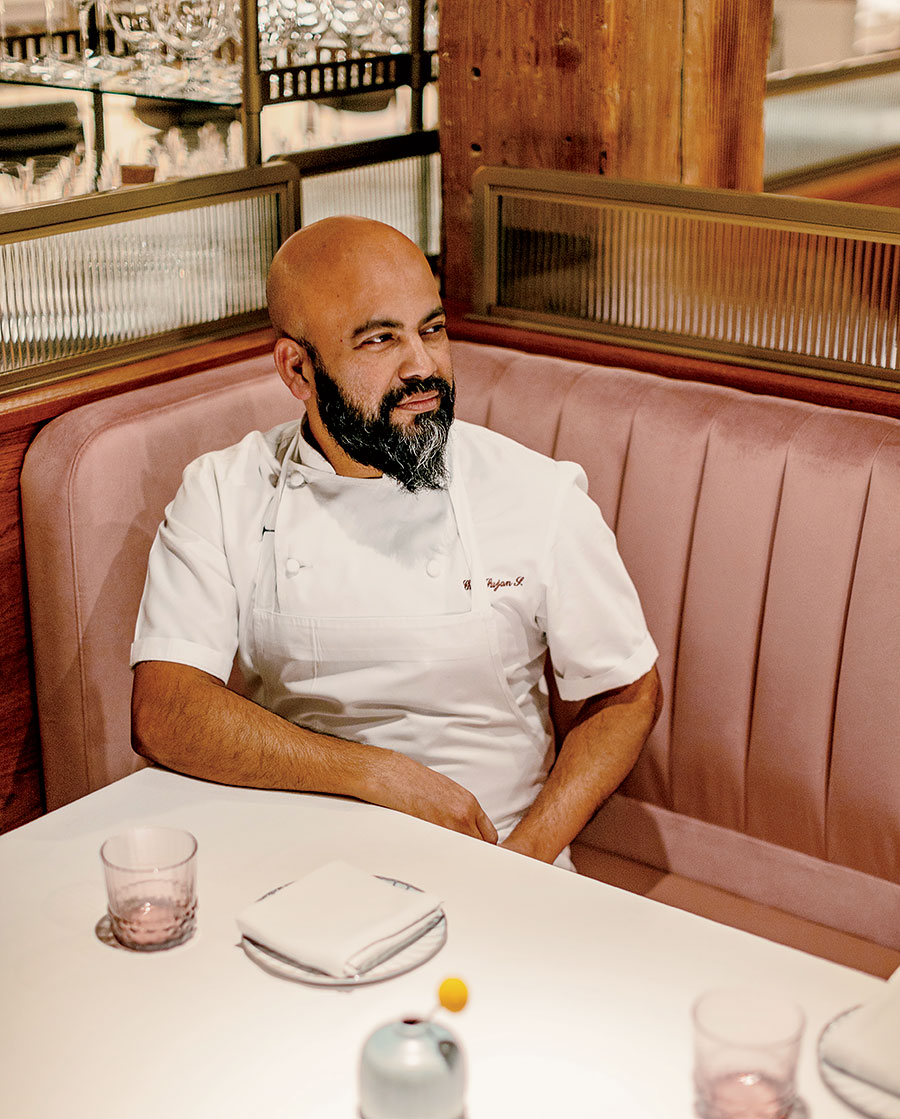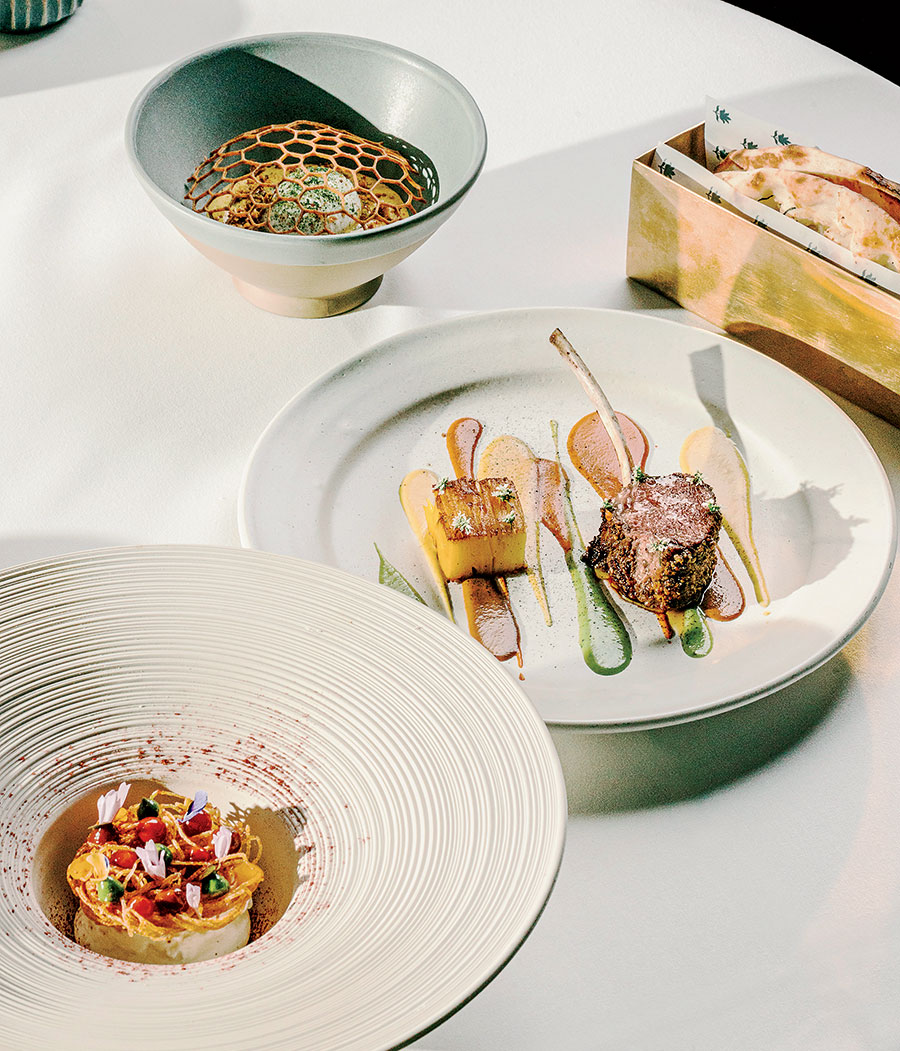If you want to know where Sujan Sarkar’s career as a chef has taken him, crack open the leather-bound cocktail list at Indienne, where each drink is named for a stop on his culinary journey. The beverages on the left (Kolkata, Mumbai, Goa) show he has cooked around his native land, while those on the right (New York, San Francisco, Dubai) point to his international postings. He tells his story, and does it well. His menu includes call-outs to regional Indian specialties and also offers a cosmopolitan sense of fine dining.
But I’m surprised there’s no cocktail called London, where Sarkar spent 11 years, because that’s what I get most from this new restaurant in the former Graham Elliot space in River North. It feels like a posh meal in the British capital, which boasts seven Michelin-starred Indian restaurants. From the moment his version of chaat — a street snack reimagined as a construction of textured yogurts, dollops of colorful sauce, and fried potato wisps — hits the table, I was reminded of meals I had mostly enjoyed in the U.K. and in fancy hotels in India. Meals that were beautiful, playful, and indulgent, if not always complexly spiced or soulful.
Sarkar first came to Chicago in 2019 with Good Times Restaurants to launch a branch of Rooh, a classy Indian spot that had opened in San Francisco to rave reviews. After breaking ranks with the local operators of Rooh, he decided to go out on his own here. With our love of tasting menus, our Michelin-starred status, and our reputation as a destination for culinary tourists, he chose well. Indienne’s menu ($95 for vegetarian and $105 for omnivorous) is reasonable by today’s standards. Though it doesn’t shower diners with caviar and wagyu like others, it truffles up nicely, and there is a lamb chop worthy of a happy dance.
Indienne does a lot well — enough to earn it a spot on Esquire’s 2022 list of the country’s best new restaurants. The space is handsome, with dusty rose booths and art deco lines. Soft EDM reminds you that you once liked to go clubbing, while soft lighting appeals to the more mature you. The tasting menus are filled with two-bite delights, like a mushroom cream éclair showered with shaved truffle, or a dessert of airy ras malai (cheese dumpling) in crème anglaise that thinks it’s a floating island. A passionfruit tartelette bursts with juice in your mouth; it’s a fun take on pani puri and a recipe that has followed Sarkar from restaurant to restaurant. The chicken thigh and leek terrine in silken Amul cheese sauce could be the glory of a French bistro menu.
There are also missteps: an egg curry rendered as foamy gloop and sided by utterly stale pao bread; a $25 supplemental course of flavorless lobster tail in yet another softly creamy and undersalted sauce. But by the time we got to that spice-crusted lamb chop, we were yumming out, particularly for the blistered naan and layered-with-spice dal makhani that arrived alongside. The plate was painted with sauces that supposedly represented the four corners of India and looked like the pattern on a dress worn by an Austin Powers fembot. I wouldn’t have minded if a couple of the dull courses had been edited out, along with 60 minutes from the three hours this dinner took. But all in all, the vegetarian and meat eaters in our party, the Indian and the Americans, left smiling.

Still. The meal was notable more for its decorousness than for its depth, a pleasure as it was happening but hard to recall the next day. It got me wondering: Who is this chef, and what is his food about? When I interviewed Sarkar, he drew my attention toward his glittery press materials, but my later research showed they had their share of bluster and holes.
For instance, his official bio claims that he opened Trèsind, a restaurant in Dubai, yet its chef, Himanshu Saini, says Sarkar was only part of the preopening team and left nearly a month before it debuted. According to materials sent by his publicist, he worked for “Michelin-starred restaurants in London for more than a decade,” but my research suggested otherwise, and his publicist later clarified that he worked “for about a year” in a Michelin one-star in the Hilton Hotel. He spent the majority of his time there at Automat, a clubby American spot with truffled mac and cheese, burgers, and pancake brunches.
After his London employer went into bankruptcy protection, he returned to India, where he found success with a restaurant group that had sceney Western establishments. By the time he arrived in America, he was a modernist practitioner of Indian cooking, serving food that was strikingly similar to that at the many chic Indian restaurants in Mayfair, near where he worked in London. While at Rooh, he was known for taking his team out to the city’s more progressive Indian venues and then trying out variations on their recipes.
Which brings us to Indienne. Because Sarkar cut his teeth at trendy bars, I sat at the counter for my second visit and explored the à la carte menu and some of those geographic beverages crafted by Chetan Gangan, who has been with him since they worked at Delhi’s Ek Bar. The drinks are gorgeous, each with its own bespoke ice cube and garnish. They’re all a bit sweet for my taste, but complex enough to merit further exploration. The à la carte food is very good. Avocado bhel is such a nifty surprise that I want to recommend it without spoilers. A supple octopus leg with miso sauce and fermented gooseberry jam (supposedly a variation on Goan crab xec xec) is globetrotter grub done exquisitely right. Add in that spice-thrumming dal and saffron rice, and not only have you had a satisfying meal, you’ve found the best way to enjoy Indienne.
I am impressed with Sarkar’s technical prowess and his crowd-pleasing flavors. I have trouble locating real personality in his cooking though. If Indienne is successful, I hope one day he’ll show us who he really is.



